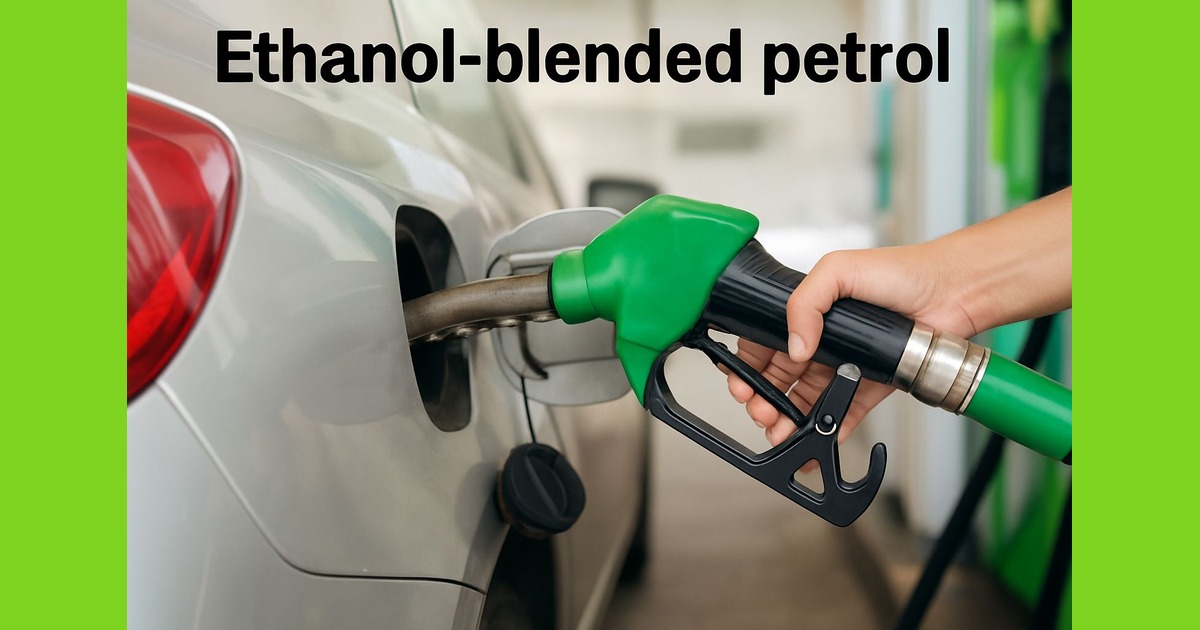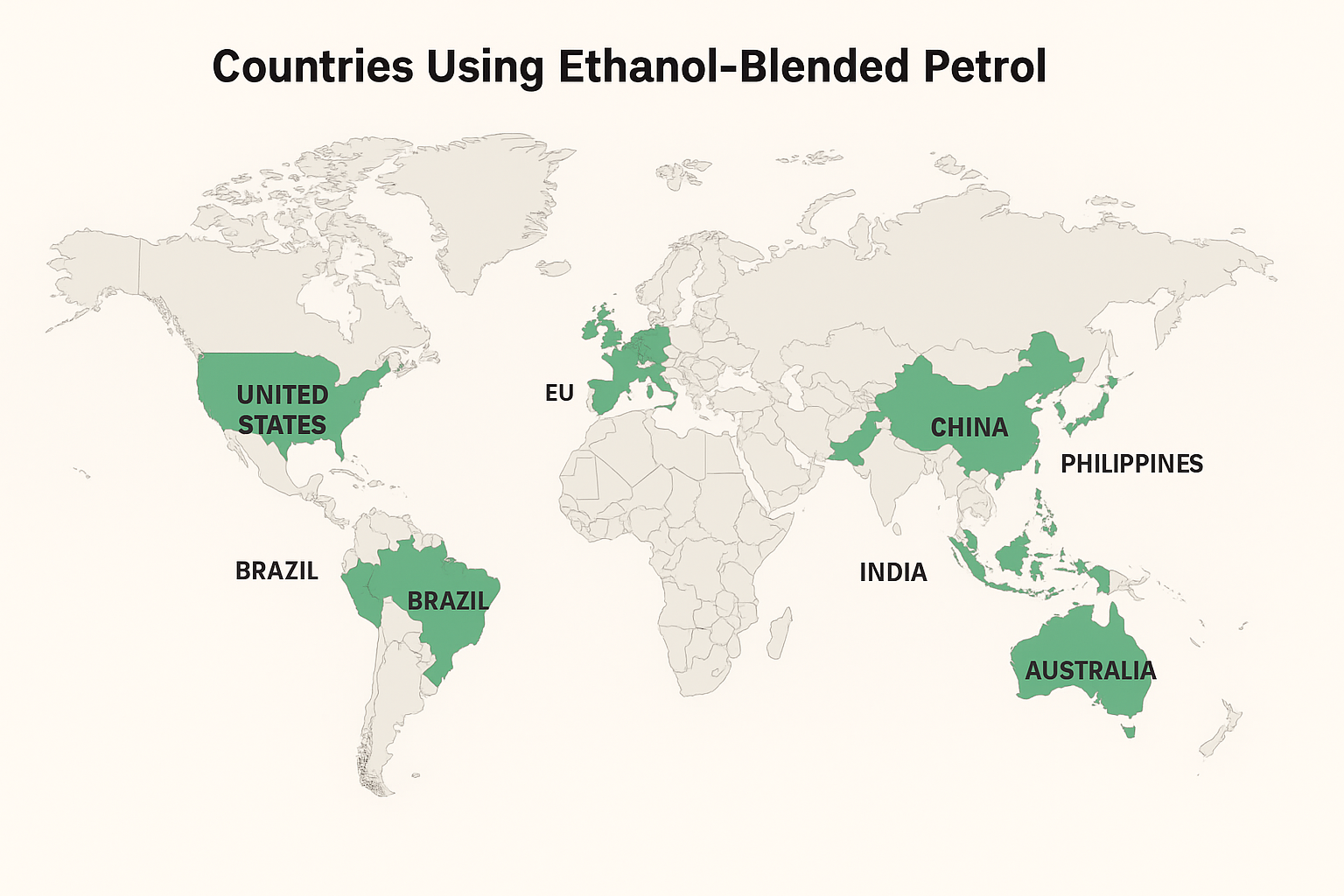
E20 is here: What India gains — and what motorists should watch out for?
India is rolling out E20 petrol nationwide. E20 is petrol mixed with 20% ethanol. The government says it will cut emissions, lift farm incomes, and reduce crude imports. Owners of older cars and bikes worry about mileage, wear, and costs. Here is a clear, detailed explainer of both sides.
What exactly is E20?
Definition: 20% ethanol + 80% petrol.
Where we are: The Centre has put out a formal defence of E20 and says the move fits India’s energy transition plan. It also says decisions on going beyond E20 will be taken only after a fresh review; the current roadmap holds at least until October 31, 2026.
Why the government backs E20
1) Energy security and farm income
Since ESY 2014–15, ethanol blending has saved ₹1.44 lakh crore in foreign exchange and substituted about 245 lakh tonnes of crude.
In 2025, at 20% blending, the government expects ₹40,000 crore to flow to farmers and about ₹43,000 crore in forex savings.
2) Lifecycle emissions
A NITI Aayog-cited assessment says ethanol made from sugarcane and maize can cut lifecycle greenhouse gas emissions by about 65% and 50%, respectively, versus petrol. Lifecycle means “from crop to tailpipe,” not just exhaust gases.
3) Higher octane, better knock resistance
Ethanol has a high octane number (about 108). Blending improves petrol’s effective octane rating. The ministry says regular petrol that met RON 91 is now RON 95 with E20, which helps modern, higher-compression engines and reduces knock.
4) International precedent
Brazil has used high ethanol blends for years. In August 2025, Brazil’s regulator ANP raised the mandated share in gasoline to 30% (E30), up from 27%. That shows long-term viability in a big, auto-heavy market.

The engineering reality in vehicles
1) Performance feel vs measured efficiency
The ministry says E20 can give better acceleration and “ride quality” in engines tuned for it. That stems from higher octane and ethanol’s higher heat of vaporisation, which can cool the intake charge.
But energy content matters. Ethanol has lower energy per litre than petrol (roughly 21 MJ/L vs ~32 MJ/L), so mileage can dip unless the engine and calibration recover that loss.
2) What official and industry studies say about mileage
Lab and field work in India have shown small drops in fuel economy with E20 in vehicles that are compatible and well tuned.
Guidance used in India cites about 1–2% drop in E20-ready vehicles and ~3–6% in older, E10-calibrated vehicles under standard tests. Real-world results vary with driving, loading, and climate.
3) Cold starts, drivability, and emissions mix
Indian test programmes found vehicles passed startability and drivability tests on E20 in both hot and cold conditions, with no severe malfunctions. Hydrocarbon and carbon monoxide emissions generally fall with ethanol blends, though some aldehydes (like acetaldehyde) can rise.
What changes for older vehicles
1) Materials and component life
Ethanol is hygroscopic (it attracts water). That can promote corrosion and stress some elastomers and plastics in older fuel systems. India’s experience and studies flagged inferior performance in some elastomers and a drop in tensile strength for certain plastics with E20 exposure.
The ministry acknowledges that some older vehicles may need rubber parts and gasket replacements earlier than with neat petrol. It calls these low-cost, routine-service jobs.
2) Maintenance patterns
Expect more frequent fuel-system attention in older cars and bikes on E20: injector cleaning, fuel-filter changes, and periodic checks for seepage. Fuel additives can help in the short term but are not a cure for material incompatibility. (See the owner checklist below.)
3) Storage and moisture
Because ethanol absorbs water, long storage, especially in humid or coastal areas, can risk phase separation in tanks and cans. Avoid long storage and keep caps sealed tight.
Alternative Fuels Data Center
Costs and the pump-price question
Ethanol procurement prices have risen. As of July 31, 2025, the weighted average procurement price was ₹71.32/L (incl. transport and GST). Prices for C-heavy molasses ethanol rose from ₹46.66 (ESY 2021–22) to ₹57.97 (ESY 2024–25); maize-based ethanol rose from ₹52.92 to ₹71.86 in the same period. This is why the ministry says a visible pump-price advantage is not guaranteed today.
Oil PSUs have continued with the mandate because of strategic and environmental goals, despite procurement parity.
Insurance, warranties, and safety standards
The ministry has called social media claims about insurance refusal for E20-related damage baseless and says insurance validity is unaffected by using E20.
Safety and quality are covered by BIS specifications for gasoline and Automotive Industry Standards (AIS) for vehicles and materials. OEMs have been offering E20-compatible models for years, though owners should still check their model-year guidance.
The environmental ledger: gains and trade-offs
1) Gains
Lifecycle GHG emissions can be lower when ethanol comes from sustainable feedstocks and efficient plants. That is the core climate case for blending.
On the tailpipe side, CO and HC usually fall with oxygenated fuel, helping urban air in stop-go traffic.
2) Caveats
Aldehydes can rise with higher ethanol blends. These are unregulated in BS-VI but monitored in research.
Water and land: Sugarcane and some grain pathways are water-intensive and can stress basins in drought years if not managed. India’s roadmap flags sustainability safeguards and second-generation (waste-based) ethanol as priorities.
How will E20 feel on the road?
New, E20-ready vehicles: You may feel sharper throttle response thanks to octane and tuning. Expect little to modest change in mileage under normal use.
Older, E10-calibrated vehicles: You may see a small but noticeable mileage dip over mixed driving, especially if the vehicle is due for service. Watch for hard cold starts, rough idle, or hesitation—all signs to service the fuel system and inspect rubber parts.
For owners: A quick checklist
Check compatibility: Look up your model and year. Many OEMs publish E20 compatibility lists; otherwise, check the owner’s manual or ask an authorised workshop.
Maintain basics: Tyre pressure, air filter, spark plugs, and timely oil changes preserve mileage far more than fuel choice alone.
Fuel-system care: Replace ageing rubber hoses, O-rings, and gaskets if there are seepage signs. Clean injectors if idle or pickup worsens.
Avoid long storage: If the vehicle sits for weeks, keep tanks topped to reduce moisture ingress. Do not stockpile fuel.
Alternative Fuels Data Center
Use reputed pumps: Quality control matters more as blends rise. Prefer busy outlets that cycle fuel quickly.
Insurance and warranty: Using the specified blend does not void insurance; for warranty, follow the OEM’s fuel and service guidance for your model-year.
The bottom line
E20 is a strategic shift. It helps India cut oil use, supports farm incomes, and can deliver cleaner combustion when feedstocks are sustainable. In new, E20-ready vehicles, the transition should be smooth, with minor or no mileage penalty. In older vehicles, expect some trade-offs—slightly lower mileage in the real world and faster ageing of a few rubber parts—both manageable with good maintenance.
Costs at the pump may not fall for now, because ethanol procurement has become costlier. But the programme targets security and sustainability, not only retail price relief. Owners can reduce risk by following the checklist above. Policymakers, for their part, must keep pushing for 2G ethanol, better water governance, and clear OEM guidance so that the benefits of E20 are broad, durable, and fair.
(With inputs from Press Information Bureau and NITI Aayog)
📍𝐏𝐮𝐧𝐞
— Nitin Gadkari (@nitin_gadkari) August 11, 2025
Addressed the 10th anniversary of #WorldBiofuelDay in India, organised by PRAJ Industries in Pune today.
Biofuels are emerging as a vital pillar in advancing India’s energy transition, reducing dependence on fossil fuels, and cutting carbon emissions. The #ModiGovt's… pic.twitter.com/ggApvaioX3
Popular Categories
Read More Articles
Travel and Tourism
Meerut’s vanishing heritage: Why its mughal treasures are crumbling away by Mohammed M. Raza November 19, 2025Business
Hafele Valeriya Dishwasher: The New Standard in Kitchen Hygiene by Awadh 360° Desk November 14, 2025Entertainment
Banaras gave me the notes, Bhatkhande polished them: Bhojpuri singer Sarita Tiwari by Awadh 360° Desk November 10, 2025Travel and Tourism
Statue of Unity Sets New Tourist Footfall Record as PM Modi Hails Vallabhbhai Patel's Legacy by Awadh 360° Desk October 31, 2025



